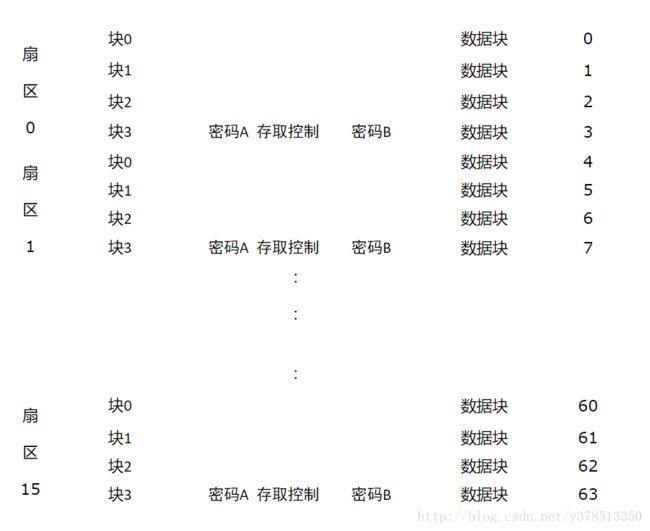Android Mifare 卡 读写
最近公司在做一个Mifare卡的读入,以及写初始(即对各扇区数据块初始化,以及将密码区还原成初始密码)。昨天刚刚完成了这个项目,正好趁着周六休息的时候把之前的做过的总结一下。同时加深印象,如果能帮到各位的,也算是意外收获吧。(* ̄︶ ̄)
Mifare卡
Mifare卡俗称M1卡,是IC卡的一种,原装芯片通常被称为NXP卡或飞利浦S50卡。通过内存大小分类,一般会有三种。
1K: 16个扇区(sector),每个分区4个块(block),每个块(block) 16个byte数据
2K: 32个扇区(sector),每个分区4个块(block),每个块(block) 16个byte数据
4K:64个扇区(sector),每个分区4个块(block),每个块(block) 16个byte数据
我们通常用的是Mifare 1K卡,而今天的主角就是它。
首先,我们对每个扇区的每一块进行初步了解。
0扇区,这个扇区比较特殊。对于0扇区0块,这一块一般是禁止写入的,可以读。里面存放着Mifare卡的ID,以及卡片厂商的一些固有信息。如果要写数据的话,只能放在1块,和2块。1块,2块是数据的存储位置,如果要写入的0扇区数据的话,只能放在1块和2块上。对于全部基于MifareClassic的卡来说,每一个区最后一个块叫Trailer,16个byte, 主要来存放读写该区的key,能够有A,B两个KEY,每一个key长6byte,默认的key通常是FF 或 0,中间4个byte则是夺取控制。
1-15扇区,则和0扇区差不多,每个扇区的第一块到第三块都可以对数据进行操作,而第四块都是统一的密码区域。
整个Mifare卡的结构如下。
好了,开始步入正题。
1. 添加相关配置
<manifest xmlns:android="http://schemas.android.com/apk/res/android"
package="cn.qy.demo">
<uses-sdk android:minSdkVersion="14" />
//添加NFC相关权限
<uses-permission android:name="android.permission.NFC" />
//手机识别NFC时,提供该程序进行选择
<uses-feature
android:name="android.hardware.nfc"
android:required="true" />
<application
android:allowBackup="true"
android:name=".MyApplication"
android:icon="@mipmap/ic_launcher"
android:label="@string/app_name"
android:roundIcon="@mipmap/ic_launcher_round"
android:supportsRtl="true"
android:theme="@style/AppTheme">
<activity
android:name=".MainActivity"
//将Activity启动模式设为singleTop避免创建实例
android:launchMode="singleTop">
<intent-filter>
<action android:name="android.intent.action.MAIN" />
<category android:name="android.intent.category.LAUNCHER" />
intent-filter>
//添加过滤
<intent-filter>
<action android:name="android.nfc.action.TECH_DISCOVERED" />
intent-filter>
//添加过滤数据
<meta-data
android:name="android.nfc.action.TECH_DISCOVERED"
android:resource="@xml/nfc_tech_filter" />
activity>
application>
manifest>在res文件下添加xml/nfc_tech_filter 文件。
<resources xmlns:xliff="urn:oasis:names:tc:xliff:document:1.2">
<tech-list>
<tech>android.nfc.tech.NfcAtech>
tech-list>
<tech-list>
<tech>android.nfc.tech.NfcBtech>
tech-list>
<tech-list>
<tech>android.nfc.tech.MifareClassictech>
tech-list>
<tech-list>
<tech>android.nfc.tech.MifareUltralighttech>
tech-list>
resources>
NFC的类别有很多的,这里只添加一部分。
2.在Activity里编写相关代码
//获取默认的NfcAdapter
NfcAdapter nfcAdapter = NfcAdapter.getDefaultAdapter(this);
//通过判断nfcAdapter是否为空来知晓该手机是否支持NFC功能
nfcAdaper == null;
//NFC是否可用(是否是打开状态)
nfcAdapter.isEnabled;onCreate 中的部分代码
nfcAdapter = NfcAdapter.getDefaultAdapter(this);
pendingIntent = PendingIntent.getActivity(this, 0,new Intent(this, getClass()).addFlags(Intent.FLAG_ACTIVITY_SINGLE_TOP), 0);
if (nfcAdapter!=null) {
if(!nfcAdapter.isEnabled()){
Toast.makeText(this,"请在系统设置中先启用NFC功能!",Toast.LENGTH_SHORT).show();
}
}else{
Toast.makeText(this,"该设备不支持NFC功能",Toast.LENGTH_SHORT).show();
}
onNewIntent(getIntent());onResume代码
if (nfcAdapter != null) {
String[][] mTechLists = new String[][] {
new String[] { NfcF.class.getName()},
new String[]{NfcA.class.getName()},
new String[]{NfcB.class.getName()},
new String[]{NfcV.class.getName()}
};
IntentFilter[] filters = null;
try {
filters = new IntentFilter[] { new IntentFilter(NfcAdapter.ACTION_TECH_DISCOVERED, "*/*") };
} catch (IntentFilter.MalformedMimeTypeException e) {
e.printStackTrace();
}
// 这行代码是添加调度,效果是读标签的时候不会弹出候选程序,直接用本程序处理,关于第四个参数,如果设置null也会启动activity并不会在当前页读取
nfcAdapter.enableForegroundDispatch(this, pendingIntent, filters, mTechLists );
}onPause代码
//关闭NFC功能
nfcAdapter.disableForegroundDispatch(this);onNewIntent代码
//从intent中获取标签信息
readTag(intent); Tag:当刷卡时,生命周期onpause->onnewintent->onresume
读卡操作:
public String readTag(Intent intent) {
Tag tagFromIntent = intent.getParcelableExtra(NfcAdapter.EXTRA_TAG);
MifareClassic mfc = MifareClassic.get(tag);
for (String tech : tag.getTechList()) {
System.out.println(tech);
}
boolean auth = false;
//读取TAG
try {
String metaInfo = "";
//读取之前必须connect();
mfc.connect();
int type = mfc.getType();//获取TAG的类型
int sectorCount = mfc.getSectorCount();//获取TAG中包含的扇区数
String typeS = "";
switch (type) {
case MifareClassic.TYPE_CLASSIC:
typeS = "TYPE_CLASSIC";
break;
case MifareClassic.TYPE_PLUS:
typeS = "TYPE_PLUS";
break;
case MifareClassic.TYPE_PRO:
typeS = "TYPE_PRO";
break;
case MifareClassic.TYPE_UNKNOWN:
typeS = "TYPE_UNKNOWN";
break;
}
metaInfo += "卡片类型:" + typeS + "\n共" + sectorCount + "个扇区\n共"
+ mfc.getBlockCount() + "个块\n存储空间: " + mfc.getSize()
+ "B\n";
for (int j = 0; j < sectorCount; j++) {
//通过keyA进行验证
auth = mfc.authenticateSectorWithKeyA(j,
MifareClassic.KEY_DEFAULT);
int bCount;
int bIndex;
if (auth) {
metaInfo += "Sector " + j + ":验证成功\n";
// 读取扇区中的块
bCount = mfc.getBlockCountInSector(j);
bIndex = mfc.sectorToBlock(j);
for (int i = 0; i < bCount; i++) {
byte[] data = mfc.readBlock(bIndex);
metaInfo += "Block " + bIndex + " : "
+ bytesToHexString(data) + "\n";
bIndex++;
}
} else {
metaInfo += "Sector " + j + ":验证失败\n";
}
}
return metaInfo;
} catch (Exception e) {
Toast.makeText(this, e.getMessage(), Toast.LENGTH_LONG).show();
e.printStackTrace();
} finally {
if (mfc != null) {
try {
mfc.close();
} catch (IOException e) {
Toast.makeText(this, e.getMessage(), Toast.LENGTH_LONG)
.show();
}
}
}
return null;
}写卡操作:
这里对1扇区的块4进行写操作,将块4的数据初始。
public void writeTag(Intent intent) {
Tag tagFromIntent = intent.getParcelableExtra(NfcAdapter.EXTRA_TAG);
MifareClassic mfc = MifareClassic.get(tagFromIntent);
try {
mfc.connect();
boolean auth = false;
auth = mfc.authenticateSectorWithKeyA(sector, MifareClassic.KEY_DEFAULT);
if (auth) {
mfc.writeBlock(4,new byte[16]);
mfc.close();
}
} catch (Exception e) {
e.printStackTrace();
} finally {
try {
mfc.close();
} catch (IOException e) {
// TODO Auto-generated catch block
e.printStackTrace();
}
}
}对于Mifare 卡写入要求必须是16字节。如果数据清空的话,可以直接传入空的byte[16]。
好了,今天就先介绍到这,如果有不对的地方还望各位指出。
ヾ(@^▽^@)ノ
